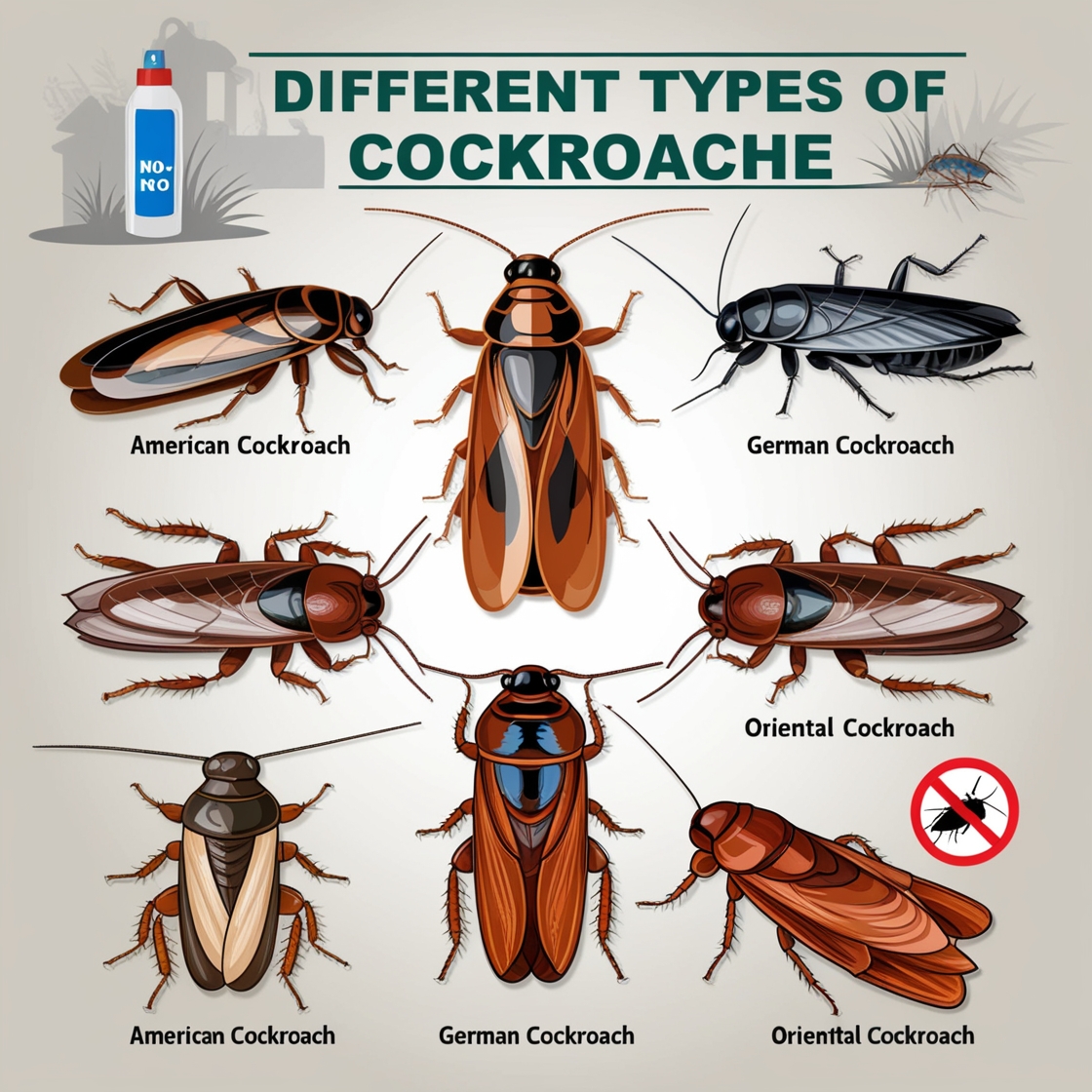Different Types of Cockroaches: Species and Pest Control

Discover the different types of cockroaches that may invade your kitchen. Learn how to identify different cockroach species and effective pest control methods.
Introduction to Cockroaches
Cockroaches are one of the most notorious pests found in homes and businesses worldwide. These resilient insects have been around for millions of years, adapting to various environments and becoming a significant nuisance for humans. Understanding the different types of cockroaches and effective pest control methods is crucial for maintaining a clean and healthy living space.
What are cockroaches?
Cockroaches are insects belonging to the order Blattodea. They are characterized by their flat, oval-shaped bodies, six legs, and long antennae. These bugs are often brown or dark brown in color, though some species may have distinctive markings or colors. Cockroaches are known for their ability to survive in various conditions and reproduce quickly, making them a persistent pest problem.
Why are cockroaches considered pests?
Cockroaches are considered pests for several reasons. They can carry and spread various pathogens, contaminate food, and trigger allergies and asthma in some individuals. Moreover, cockroaches are often associated with unsanitary conditions, making their presence distressing for homeowners and businesses alike. Their ability to reproduce rapidly and adapt to different environments makes cockroach control a challenging task for pest management professionals.
Common Types of Cockroaches
Several cockroach species are commonly found in homes and buildings. Understanding the characteristics of these different types of roaches is essential for effective pest control.
American Cockroach
The American cockroach (Periplaneta americana) is one of the largest cockroach species commonly found in the United States. These pests can grow up to 1.5 inches long and are reddish-brown in color with a yellowish figure-8 pattern on the back of their head. American cockroaches prefer warm, humid environments and are often found in basements, sewers, and drains. They can live for up to two years and reproduce quickly, with females producing up to 16 eggs at a time in their egg cases.
German Cockroach
The German cockroach (Blattella germanica) is perhaps the most common cockroach species found in homes and buildings. These pests are smaller than American cockroaches, typically measuring about 0.5 inches in length. German cockroaches are light brown in color with two dark stripes running down their backs. They reproduce rapidly and are often found in kitchens and bathrooms, where they seek out food, water, and warmth. German cockroaches can quickly lead to a severe infestation if not addressed promptly.
Oriental Cockroach
Oriental cockroaches (Blatta orientalis) are often referred to as “water bugs” due to their preference for damp environments. These cockroaches are dark brown or black in color and grow to about 1 inch in length. Oriental cockroaches are commonly found in basements, crawl spaces, and areas with high moisture levels. They are less likely to be found indoors compared to German or American cockroaches but can still become a significant pest problem if left unchecked.
Brown-Banded Cockroaches
Brown-banded cockroaches (Supella longipalpa) are named for the light brown bands that run across their wings. These pests are smaller than American cockroaches, typically measuring about 0.5 inches in length. Unlike other common cockroach species, brown-banded cockroaches prefer drier environments and are often found in upper areas of buildings, such as behind picture frames or in furniture. They can be a particularly challenging pest to control due to their tendency to spread throughout a structure.
Other Cockroach Species
Common cockroach species around the world
While the American, German, Oriental, and brown-banded cockroaches are among the most common types of roaches, there are several other species that can be problematic in certain regions. These include:
1. Smoky Brown Cockroach (Periplaneta fuliginosa): Often found in the southern United States, these cockroaches are similar in size to American cockroaches but have a uniform dark brown color.
2. Asian Cockroach (Blattella asahinai): Closely related to the German cockroach, this species is more commonly found outdoors and is attracted to light.
3. Field Cockroaches (Blattella vaga): These cockroaches prefer outdoor environments but can occasionally make their way indoors.
4. Beetle Cockroaches (Diploptera punctata): Native to Asia, these unique cockroaches resemble beetles and are less common as household pests.
What do different types of roaches look like?
Identifying cockroaches can be crucial for effective pest control. Here are some key features to look for:
– Size: Cockroaches can range from 0.5 to 2 inches in length, depending on the species.
– Color: Most cockroaches are brown, ranging from light brown to dark brown or reddish-brown.
– Markings: Some species have distinctive markings, such as stripes or bands.
– Antennae: All cockroaches have long antennae, often as long as their bodies.
– Wings: While most cockroach species have wings, not all can fly effectively.
Identifying Cockroach Infestations
Signs you may have cockroaches
Recognizing the signs of a cockroach infestation early can help prevent a small problem from becoming a major pest control issue. Common indicators include:
1. Cockroach sightings: Seeing live or dead cockroaches is the most obvious sign of an infestation.
2. Droppings: Cockroach feces resemble coffee grounds or pepper grains.
3. Egg cases: Empty or intact ootheca (egg cases) may be found in hidden areas.
4. Unusual odors: Large infestations can produce a musty or oily smell.
5. Smear marks: Dark, irregular smears on surfaces where cockroaches frequently travel.
Where to find cockroaches in your home
Cockroaches prefer warm, humid environments with access to food and water. Common hiding spots include:
1. Kitchens: Behind appliances, in cabinets, and under sinks.
2. Bathrooms: Around plumbing fixtures and in dark, damp areas.
3. Basements: Especially in areas with high moisture levels.
4. Crawl spaces: These dark, often humid areas are ideal for cockroaches.
5. Wall voids: Cockroaches can hide inside walls, especially near heat sources.
6. Drains and sewers: Some species, like oriental cockroaches, are often found in these areas.
Cockroach Control and Pest Management
Prevention strategies
Preventing cockroach infestations is key to effective pest management. Here are some strategies to deter these pests:
1. Maintain cleanliness: Regularly clean kitchens, bathrooms, and other areas where food and moisture are present.
2. Seal entry points: Caulk cracks and crevices in walls, floors, and around pipes to prevent cockroaches from entering.
3. Reduce moisture: Fix leaky pipes and use dehumidifiers in damp areas like basements.
4. Store food properly: Keep food in sealed containers and avoid leaving pet food out overnight.
5. Declutter: Remove cardboard boxes and other potential hiding spots.
How to get rid of cockroaches
If you find cockroaches in your home or business, there are several methods to eliminate them:
1. Baits: Cockroach baits contain insecticides mixed with attractive food sources.
2. Traps: Sticky traps can help capture cockroaches and monitor infestation levels.
3. Insecticide sprays: These can be effective but should be used cautiously, especially in food preparation areas.
4. Boric acid: This natural substance can be an effective long-term control method when applied properly.
5. Diatomaceous earth: This natural powder can dehydrate cockroaches but must be applied in dry areas.
H3: Professional pest control options
For severe infestations or persistent problems, professional pest control services may be necessary. Pest management professionals can:
1. Conduct thorough inspections to identify the extent of the infestation.
2. Implement an integrated pest management approach tailored to your specific situation.
3. Use professional-grade products and equipment for more effective control.
4. Provide ongoing monitoring and prevention strategies to avoid future infestations.
Health Risks and Environmental Impact
Diseases associated with cockroach infestations
Cockroaches can pose significant health risks, including:
1. Allergies and asthma: Cockroach allergens can trigger allergic reactions and asthma attacks.
2. Food contamination: Cockroaches can spread bacteria like Salmonella and E. coli.
3. Parasitic worms: Some cockroach species can carry parasitic worm eggs.
Ecological role of cockroaches
While cockroaches are often viewed negatively, they do play important ecological roles in natural environments:
1. Decomposers: Cockroaches help break down decaying organic matter in ecosystems.
2. Food source: Many animals, including birds and small mammals, feed on cockroaches.
3. Soil enrichment: Cockroach droppings can contribute to soil fertility in natural settings.
Conclusion: Dealing with Cockroaches Effectively
Understanding the different types of cockroaches and their behaviors is crucial for effective pest control. By implementing prevention strategies, promptly addressing infestations, and seeking professional help when needed, you can successfully manage cockroach problems in your home or business. Remember that cockroach control often requires a combination of methods and ongoing vigilance to maintain a pest-free environment.
